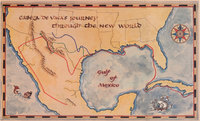The Route
Historians and archeologists have long been interested in determining Cabeza de Vaca's exact route across Texas and the Southwest.
Because Cabeza de Vaca's La relación offers an important early glimpse of the native peoples, our understanding of those cultures can be greatly enhanced by pinpointing exactly where Cabeza de Vaca traveled.
Several routes have been suggested over the years, and many Texas historians - perhaps not surprisingly - have favored interpretations that place Cabeza de Vaca traveling directly through the heart of the state.
Yet as historian Donald Chipman writes, "Any detailed analysis of the Cabeza de Vaca journey requires... the route interpreter [to] coordinate the texts... with all available data: physiography, time and distance of travel, ethnographic information, biota, geographic knowledge, geographic perceptions of the castaways, and the overall objective of the trek, which... was to reach Panuco on the gulf coast of Mexico. The problem with too many route interpretations has been the lack of objectivity, or a somewhat myopic concentration on only one or two indices."
In recent years, additional research, making use of the interdisciplinary methods of analysis as outlined by Chipman, has revealed a different route entirely, giving us a stronger sense than ever of Cabeza de Vaca's travels during his eight year odyssey.
- In Search of Cabeza de Vaca's Route across Texas: An Historiographical Survey
-- By Donald E. Chipman - Pinon Pines and the Route of Cabeza de Vaca
-- In 1997 a new study helped pinpoint aspects of Cabeza de Vaca's route by making full use of interdisciplinary scholarship.


